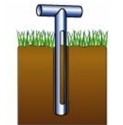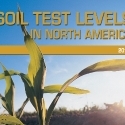08 Feb 2013
Northeastern US Soil Test K
Soil Test Summaries
The different soil tests for potassium generally have a similar interpretation. For example, a value obtained by an ammonium acetate extraction is considered similar to one from a Mehlich-3. Nevertheless, interpretations and critical levels do vary across the Northeast depending on crop, soil texture and recommendation approach.
Information on crop nutrient balances is available in the new IPNI publication, A Preliminary Nutrient Use Geographic Information System (NuGIS) for the U.S.
Compared to 2005, the proportion of soils testing higher than 160 ppm for potassium decreased, while that of soils testing in the range of 80 to 160 ppm increased. Critical levels for most states fall within the latter range, and are noted below for individual states. These soils require close monitoring to prevent potassium deficiencies.
Soil test K in Michigan shifted downwards since 2005, coming close to the levels of 2001. Fully 62% of Michigan soils tested below the critical level of 150 ppm.
The state of Ohio saw a huge increase in soil sampling, and the distribution of soil test K shifted downward substantially. Ohio's soils however are historically rich in potassium. About 36% of soils test below 125 ppm, an average critical value. In Ohio, critical levels are calculated specific to each soil's cation exchange capacity.
Potassium levels in Pennsylvania soils declined only modestly. About 25% of soils tested below the critical value of 100 ppm.
In New York the frequency of very low soil test K declined, with a shift to moderate levels. About 22% of soils tested below the critical value if 75 ppm is assumed. The actual critical value depends on soil classification.
The state of Vermont shows a downward shift in soil test K. The break between optimum and high levels is 130 ppm for Vermont. About 77% of soils tested below this level.
The region of Connecticut, Massachusetts, New Hampshire and Rhode Island is amalgamated owing to the small agricultural area. Soil test K shifted downwards since 2005. About 56% of soils tested below 125 ppm.
In Maine the proportion of soils testing 80 to 240 ppm increased, while those below and above this range decreased. Critical levels range from 140 ppm for grass and grains to 225 ppm for potatoes. About 53% of soils tested below 140 ppm.
Soil test K shifted downward in New Jersey. About 30% of soils tested below the critical level of 80 ppm.
The distribution of soil test K changed little in Delaware, although the proportion in the optimum range increased. About 40% of soils tested below the critical value of 90 ppm.
The distribution of soil test K shifted downwards in Maryland. Only 16% of soils tested below the critical level of 65 ppm.
Soils of Virginia appear to have become richer in potassium. About 58% of soils tested below the critical level of 100 ppm.
A much smaller sampling of soils was obtained in 2010 compared to 2005 in West Virginia. Only about 15% of soils tested below the critical level of 60 ppm.
Soil test equivalency assumptions.
The above equivalencies were assumed for the purpose of estimating soil test level frequency distributions across wide areas. They are not recommended for use
in converting soil test values for individual fields for the purpose of determining appropriate rates to apply.


